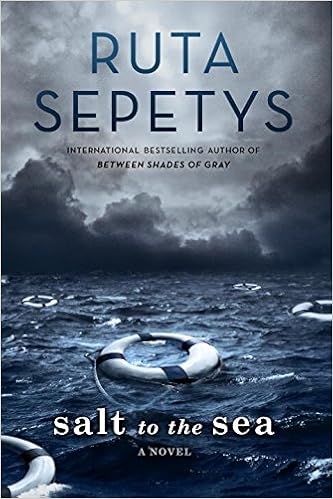 Salt to the Sea
Salt to the SeaRuta Sepetys
Philomel, 2016
Grades 9-up
Historical Fiction
The stories of four young people are told in alternating chapter during the final days of WWII in eastern Europe. Joana is a Lithuanian nurse searching for her mother and last surviving relative and struggling with past guilt. Florian is a Prussian artist and master forger running away with a priceless treasure in his pack and a host of secrets that are slowly revealed as the book progresses. Emilia is a desperate Polish girl fleeing from the Russian invasion of her family farm and hiding a shocking secret. Alfred, a young Nazi soldier, tells his tale with bravado and swagger in letters he writes to a girl back home in his head. But is he really as brave as he claims and is he a reliable narrator? Our three main characters meet each other in the woods of war-torn East Prussia and Poland. They are part of a group of refuges traveling together, each with their own baggage and story. After many near-death encounters and tragic episodes, the rag-tag group finally makes it to the port city of Gotenhafen. Here they meet Nazi soldier Alfred (and fourth narrator). The group must secure passage on one of the ship leaving port before the Russians arrive, all while hiding their secrets. Other members of the larger group they were traveling with disappear, but the core three make it on the ship the Wilhelm Gostloff, as well as their companions a lost six-year-old boy and an elderly shoemaker. Emilia's secret helps her to secure passage on the boat: she is with child. She gives birth soon after settling into the infirmary and the true parentage of her child is revealed. Just when the passengers seem safe, tragedy strikes again. Russian torpedoes bomb the Wilhelm Gustloff sending all four of our narrators in search of lifeboats and survival. Some of the characters make it and some don't. Sepetys offers us closure by including a cleverly composed epilogue at the end, tying up loose ends.
Sepetys (Between Shades of Grey and Out of the Easy) pens a masterpiece of a novel. It is so carefully constructed and layered that it could easily be marketed as an adult novel with teen appeal. Readers will be reminded of The Book Thief or The Boy in the Stripped Pajamas, but unlike the other titles is not about the Holocaust. Unlike any book I have ever read for young people about WWII, this book focuses on eastern European refugees. As we journey with the three wanderers we see firsthand the fear, loss, cold and desperation going through their minds as they are pushing themselves forward towards survival, all while managing to hold onto their humanity. Alfred, the young Nazi, is a particularly interesting character and we eventually see through his bravado to his mental illness and weaknesses as the book progresses. As in war-time, some characters rise above and become better people, while others become more despicable. It is fascinating to see this play out. I have never heard of the Wilhelm Gustloff. It is a real chapter from World War II history, boasting more causalities than the Titanic, yet no one has heard of it. Because of the graphic nature of some of the horrors of war described by the author, as well as the very gruesome sinking, I would only recommend this book to mature readers. The plot moves quickly and the book is impossible to put down once you get into it. The four narrators have such distinctive voices that it is not confusing to tell them apart. The four stories weave around each other seamlessly and come together in the end in a very thrilling conclusion. Give to history buffs or thoughtful young people who appreciate quality writing. Two maps (at the beginning and end of the book) show how the whole region was impacted and boundaries shifted during the war. The copy I was lucky enough to obtain is very advanced and does not have a final cover yet. The final cover is bound to be much more interesting than that at the top of this post. It has been my pleasure during my career to watch teen literature grow as a genre. It has now reached proportions of very high quality and Salt to the Sea is a perfect example of how far the genre has grown.
No comments:
Post a Comment